
There may come a point and time when you’ll need to restore your iPhone 16, or enter recovery mode. At the very least, you’ll probably need to force restart your device occasionally when it hangs. We also showcase a little known feature called wireless restore, which lets you restore a nearby iPhone 16 Pro or iPad mini 7 wirelessly via another iPhone running iOS 18.
This hands-on video showcases how to do all of the grunt work involved with maintaining your iPhone 16. Be sure to subscribe to 9to5Mac on YouTube for more iPhone tutorials.
Before starting
This guide applies to all devices included in the iPhone 16 lineup: iPhone 16, iPhone 16 Plus, iPhone 16 Pro, and iPhone 16 Pro Max. Before you begin, it’s a good idea to become well-acquainted with the physical buttons on your iPhone – as over the years, the iPhone has gained two additional new buttons.
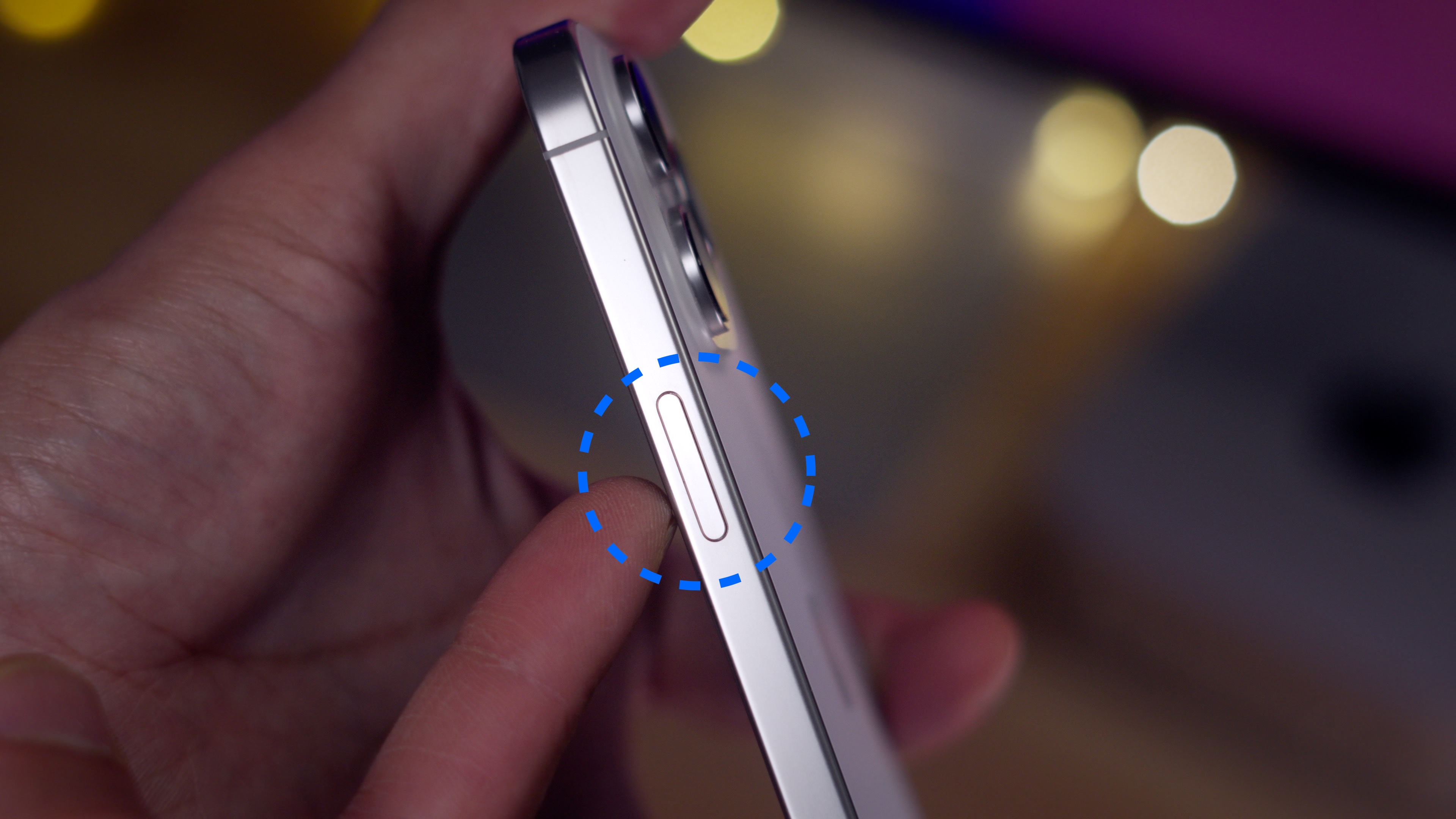
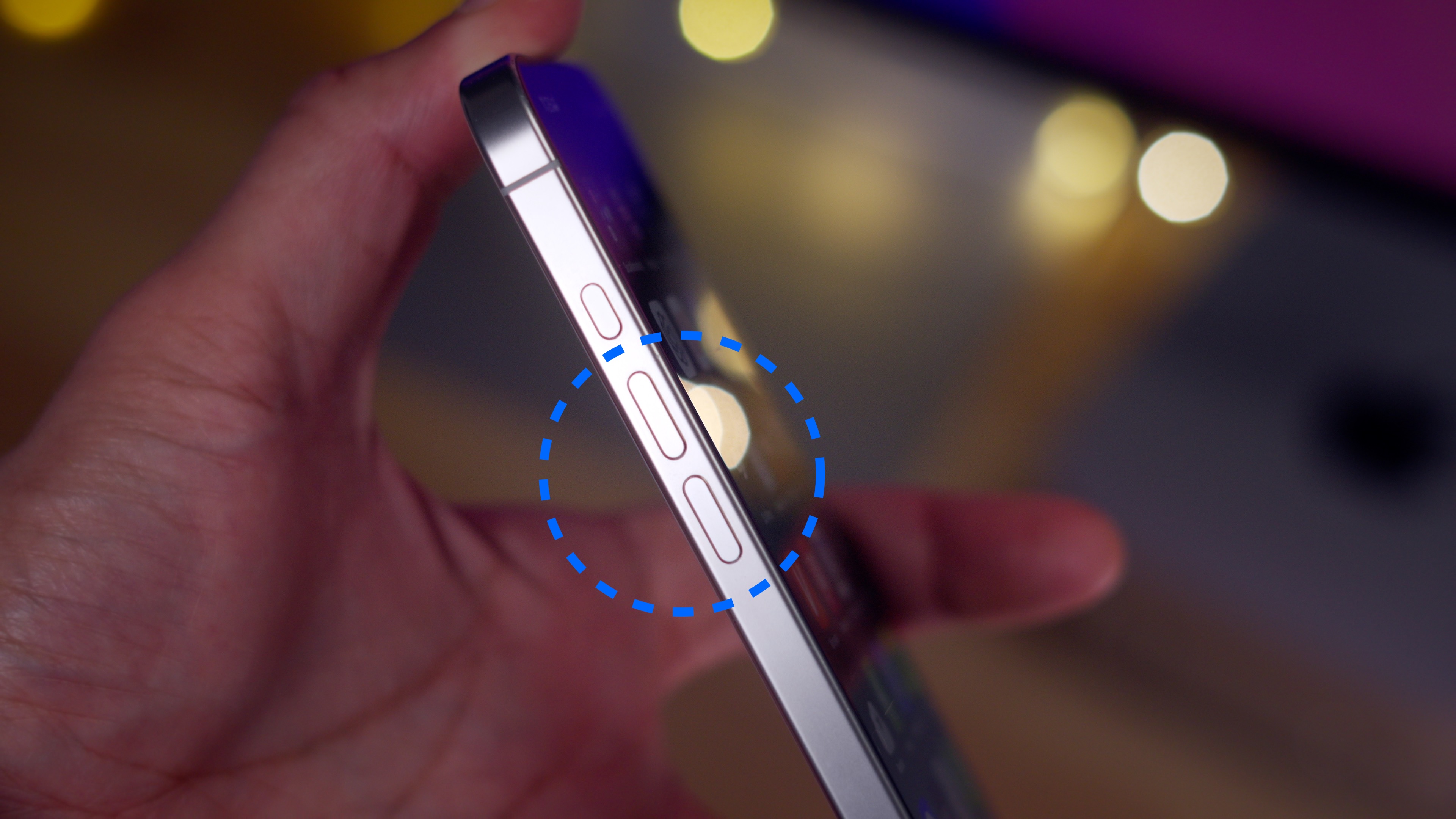
The two Volume buttons are located on the left-hand side of the iPhone 16, while the Side button is located on the right-hand side. The iPhone 16’s Action button and Camera Control button are not used in this tutorial.
Video: How to force restart iPhone 16, recovery, DFU, etc.
Subscribe to 9to5mac on YouTube for more videos
How to turn off iPhone 16
The iPhone 16 series features several different methods for powering off.
Method 1: Invoke Control Center by swiping down from the top right-hand corner, long-press the power button in the upper right-hand corner, and slide to power off.
Method 2: Long-press the Side button along with either of the Volume buttons, then slide to power off.
Method 3: Go to Settings → General, tap Shut Down at the bottom of the page, and slide to power off.
How to turn on iPhone 16
Long-press the Side button on your iPhone 16 until you see the Apple logo appear. If no Apple logo ever appears, your iPhone’s battery may be completely drained. Charge your iPhone, and then try again.
A black screen could also indicate that your iPhone has been placed into DFU mode, although this is unlikely. To exit DFU mode on iPhone 16, follow the instructions in the DFU section below.
How to force restart iPhone 16
If your iPhone 16 is hanging, or otherwise acting abnormal, pressing the following buttons in quick succession will cause your iPhone 16 to force restart.
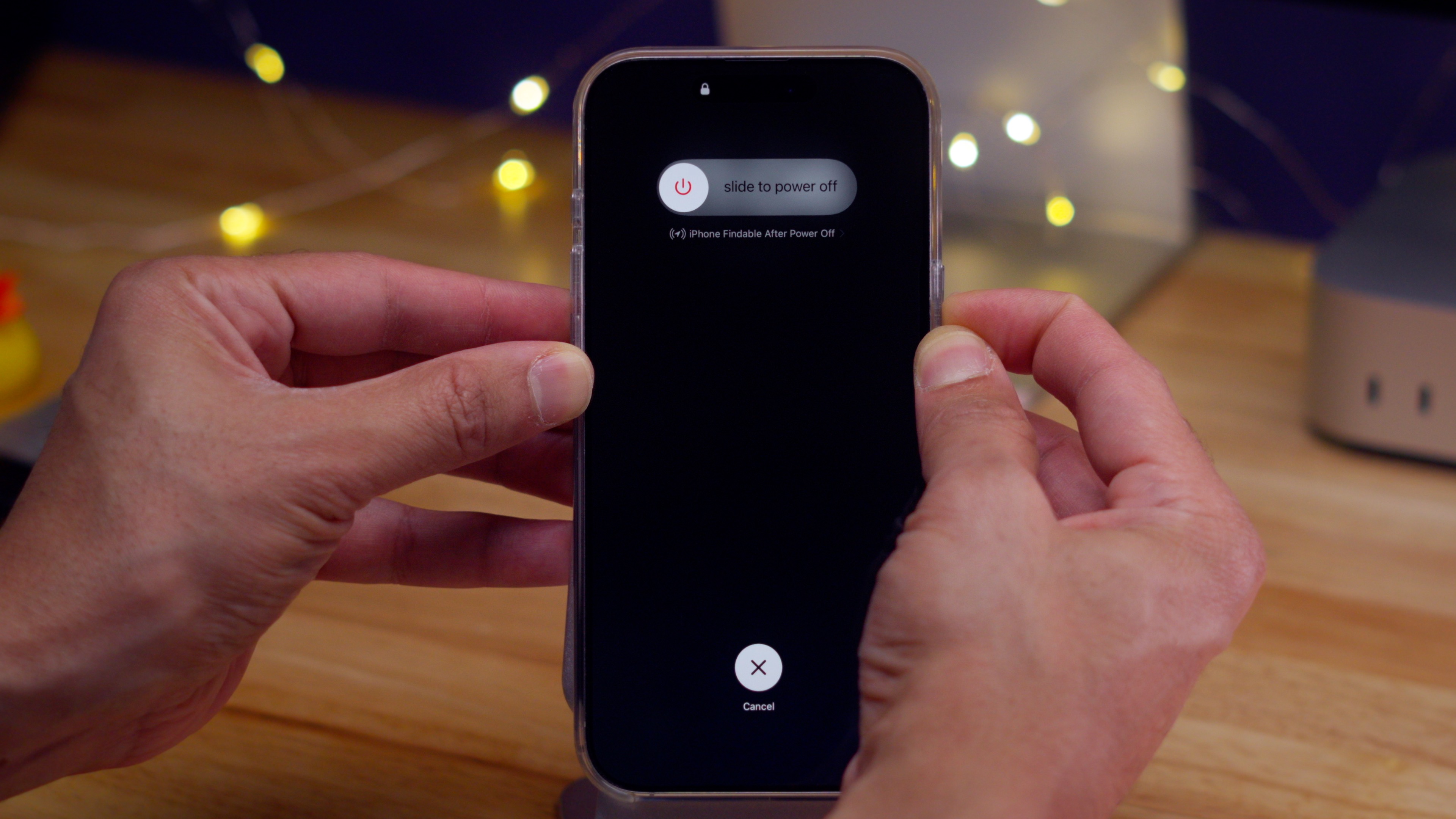
Step 1: Quick-press the Volume up and release.
Step 2: Quick-press Volume down and release.
Step 3: Long-press the Side button until your iPhone 16 turns off.
If the force restart worked, your iPhone 16 will reboot, and the Apple logo will appear. After a while, your iPhone 16 will boot back to the iOS Lock Screen.
How to enter recovery mode on iPhone 16
Placing iPhone 16 into recovery mode works much in the same way as the force restart method, though there are a few differences. First, connect a USB-C cable from your iPhone 16 to your Mac. You may use the USB-C cable that comes with your iPhone 16, a Thunderbolt cable, etc.
If this is the first time connecting your iPhone 16 to your Mac, you’ll need to tap the Trust button that appears on your iPhone and enter your iPhone’s passcode in order to create a pairing between the devices. You’ll also need to allow the device’s USB connection to your Mac by clicking the “Allow” prompt that appears on macOS. Next, open Finder, and click your iPhone 16 under the Location heading located in the Finder Sidebar. Click the Trust button that appears in the Finder to fully establish the connection.

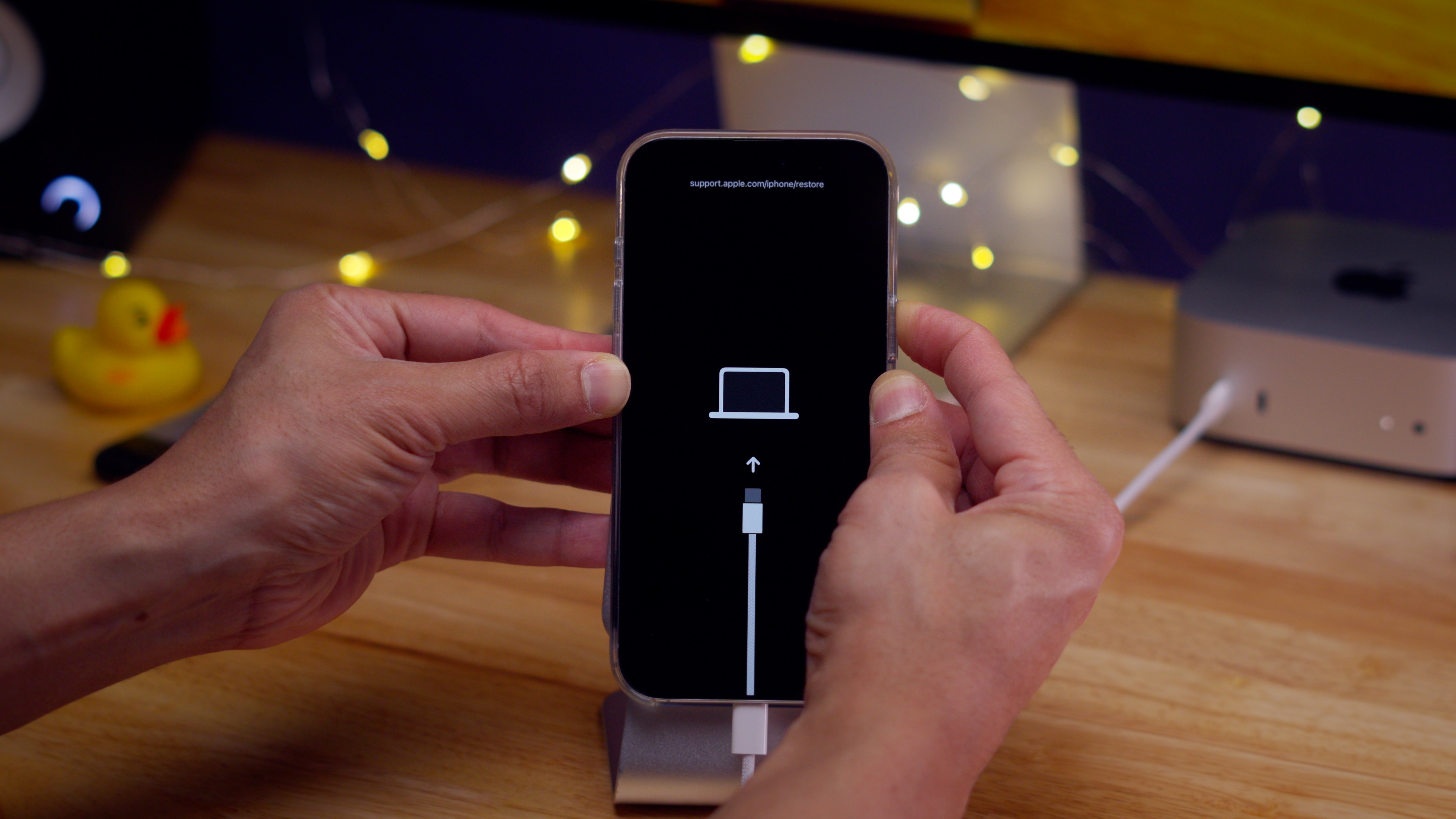
Once your iPhone 16 is connected to your Mac, do the following steps in quick succession:
Step 1: Quick-press the Volume up button and release.
Step 2: Quick-press the Volume down button and release.
Step 3: Long-press the Side button until you see the connect-to-computer screen on the iPhone 16’s display.
You’ll next see a Finder window on macOS stating that your iPhone 16 has been placed into recovery mode. macOS will provide options to either update to the latest version of iOS, retaining your data, or to restore, which installs a clean copy of the latest version of iOS without your data.
How to exit recovery mode on iPhone 16
Long-press the iPhone 16’s Side button until the connect-to-computer screen disappears. Your iPhone 16 will reboot back to the Lock Screen.
How to use wireless restore on iPhone 16
Wireless restore is a new iOS 18 feature that lets you restore an iPhone using a nearby iPhone running iOS 18 that is connected to Wi-Fi. This feature is available when your iPhone is stuck in recovery mode, such as when an update fails.
Apple has minimal documentation on wireless recovery, but it doesn’t seem that this is a feature that Apple wants users to just access, as it only appears when there is an issue with an update. In order to showcase and document this feature, I faked a bad iOS update by unplugging my USB-C cable from my iPhone mid-update, resulting in a recovery mode boot loop. Obviously I don’t recommend doing this, but I did so in an attempt to learn more about the feature.
Apple notes that wireless restore works on iPhone 16 models or the iPad mini with A17 Pro chip, but we believe it should also work for iPhone 15 Pro devices, since it contains the same A17 Pro under the hood.
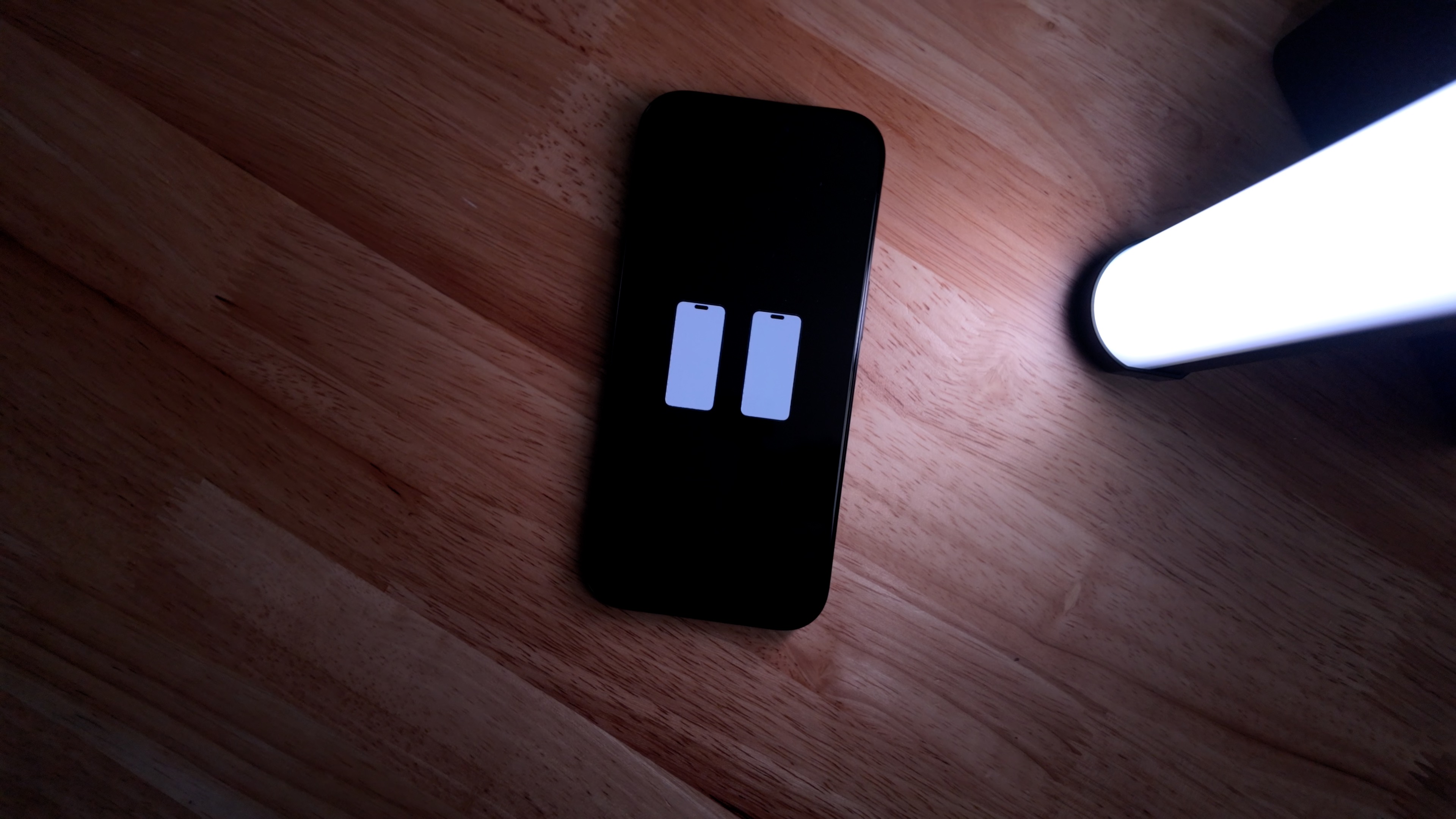
You can use wireless restore when you experience a recovery mode boot loop, i.e. when your iPhone continuously shows the connect-to-computer screen and never reboots back to the Lock Screen or iOS Setup screen successfully.
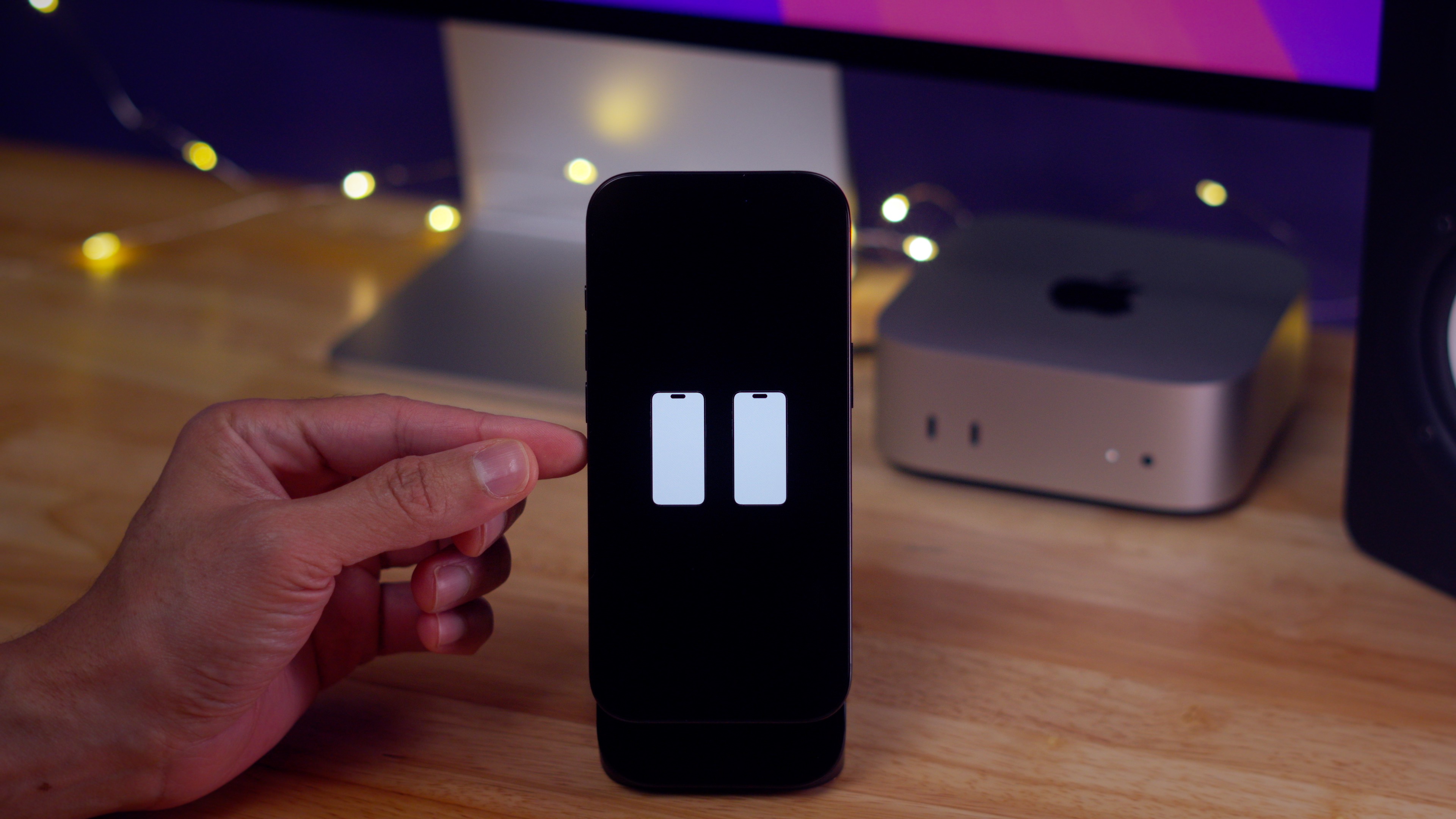
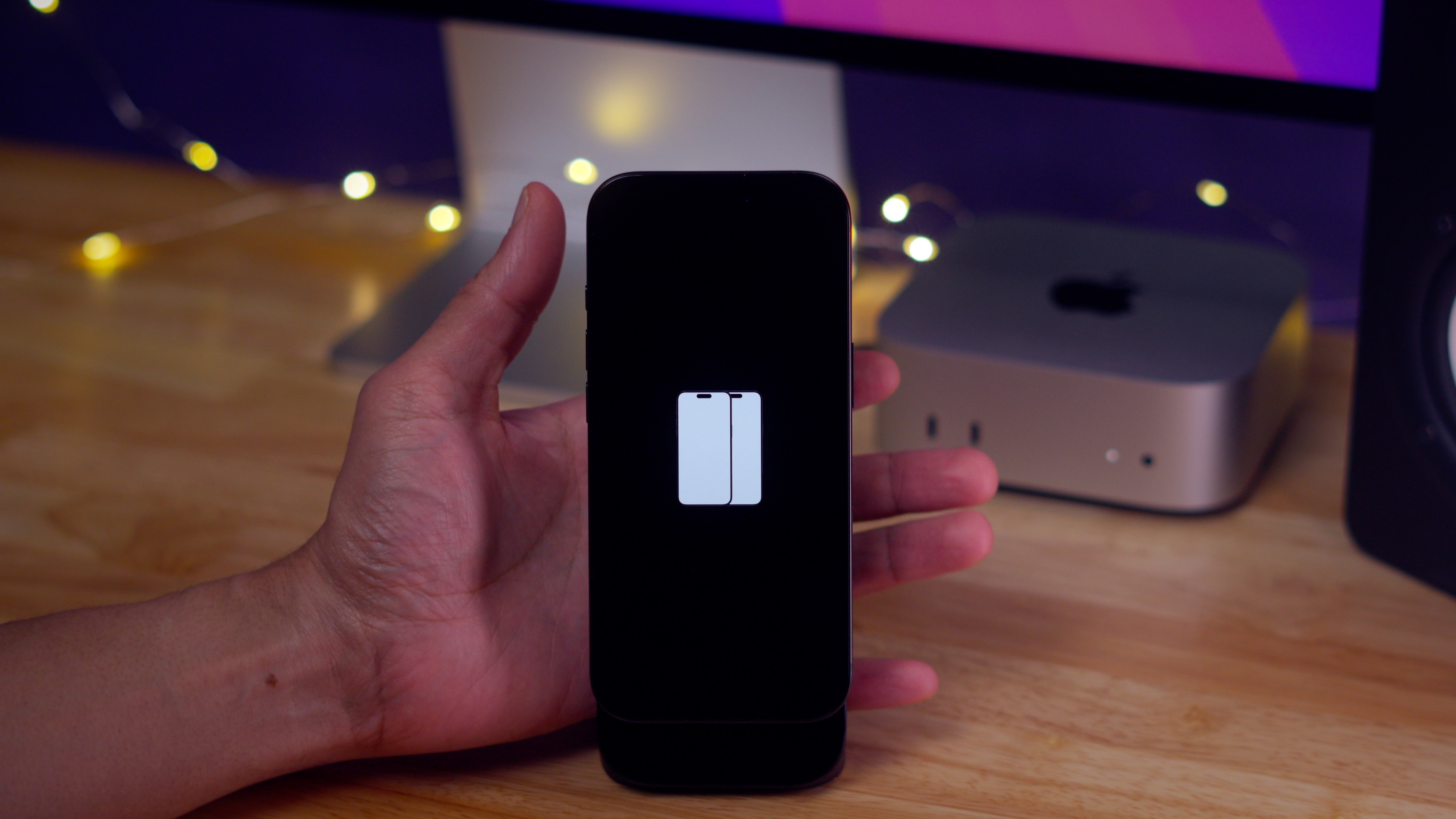
Perform the following steps while your iPhone is on the connect-to-computer screen:
Step 1: Quick-press the Volume up button and release.
Step 2: Quick-press the Volume down button and release.
Step 3: Long-press the Side button until you see the screen go black.
Step 4: Repeatedly press the Side button until you see the Apple logo appear for a brief moment, and then disappear. If the steps worked, the Apple logo will appear again, slowly fading in and out, followed by a glyph animation indicating that you should bring your iPhone close to a working iPhone running iOS 18.
Step 5: On your working iPhone, you will see a Restore Nearby iPhone dialogue. This dialogue should automatically appear when your iPhone detects an iPhone nearby in recovery mode. If you don’t see this screen, lock your device, and then unlock it.
Step 6: On your working iPhone, tap Continue.
Step 7: Your will see a code on the iPhone in recovery mode. Enter this verification code on the working iPhone.
Step 8: On the Recovery Options dialogue on the working iPhone, you will see two options: System Recovery and Exit Recovery Mode. Choose Exit Recovery Mode first, and tap Continue.
Your iPhone in recovery mode will restart, and attempt to boot back to normal. If your software update failed, it may boot back to the iOS Setup screen.
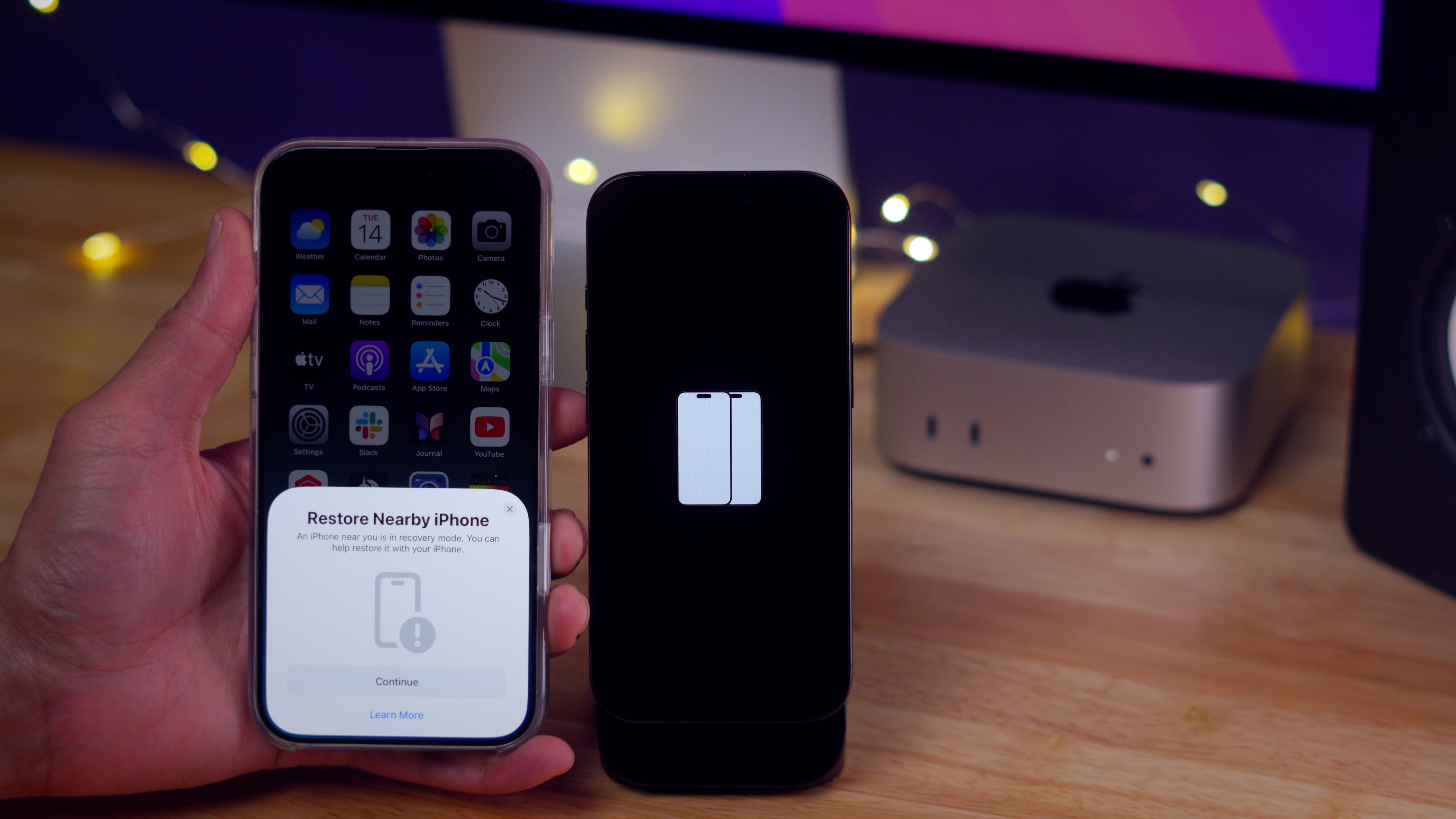
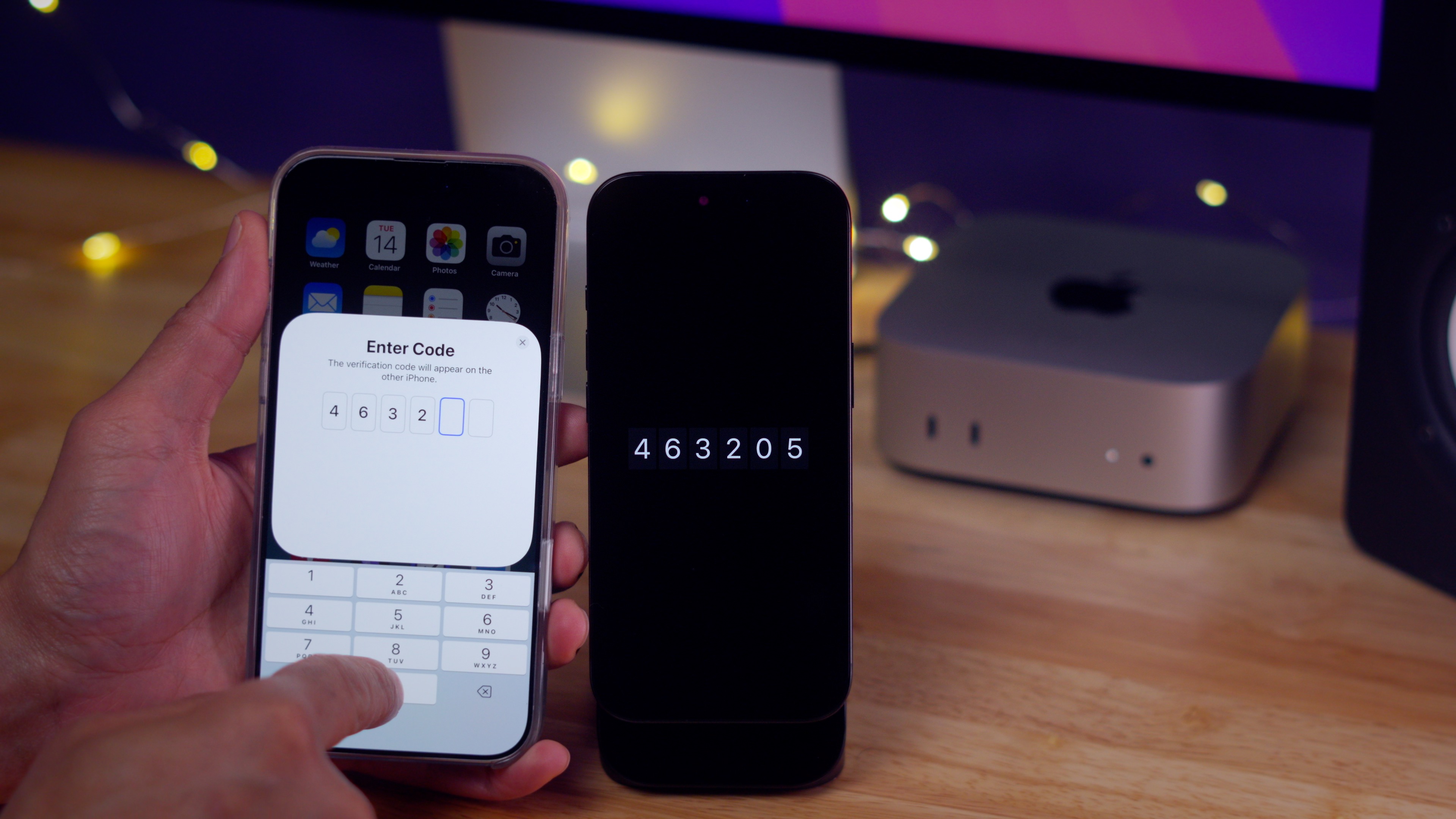
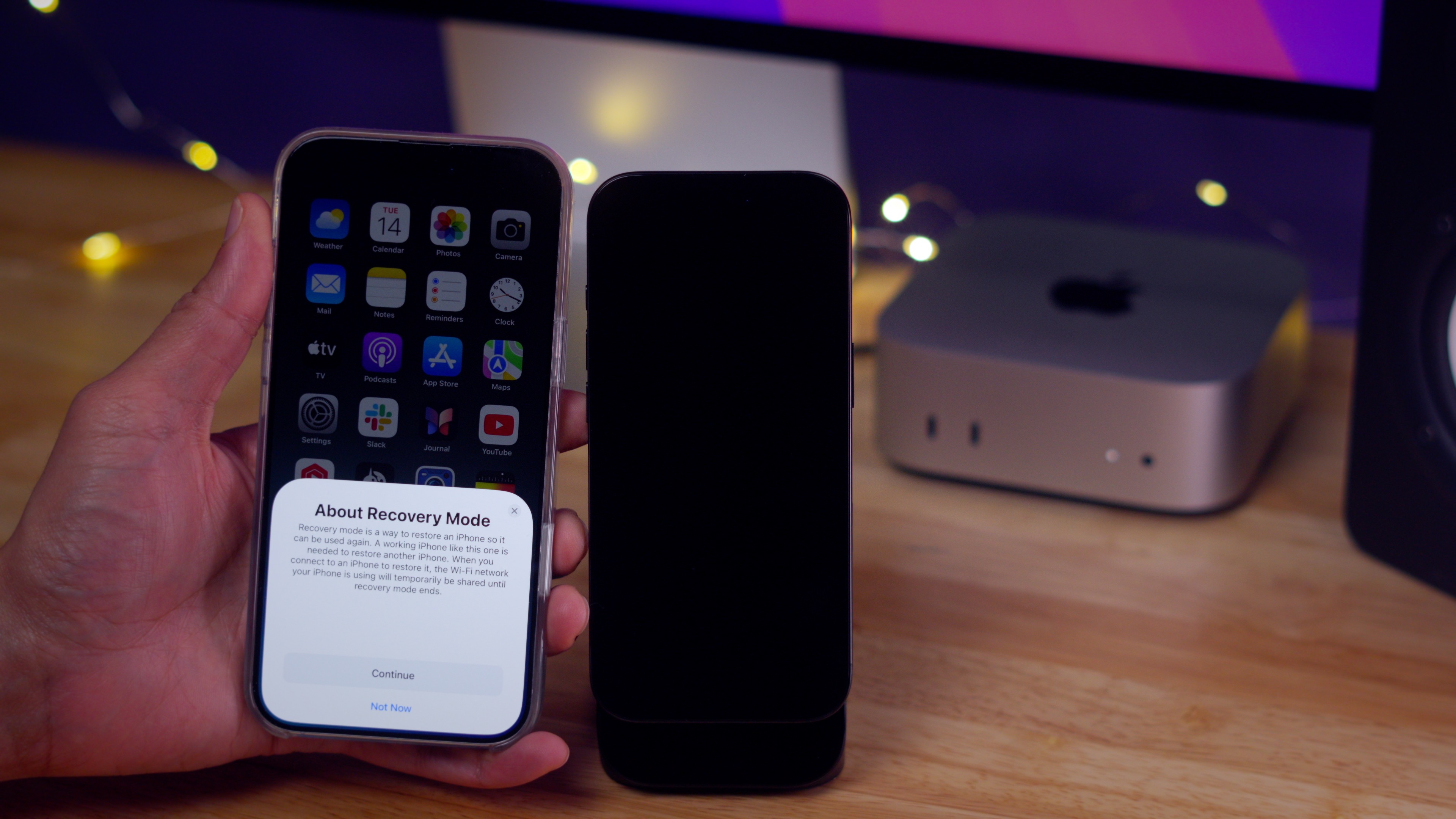
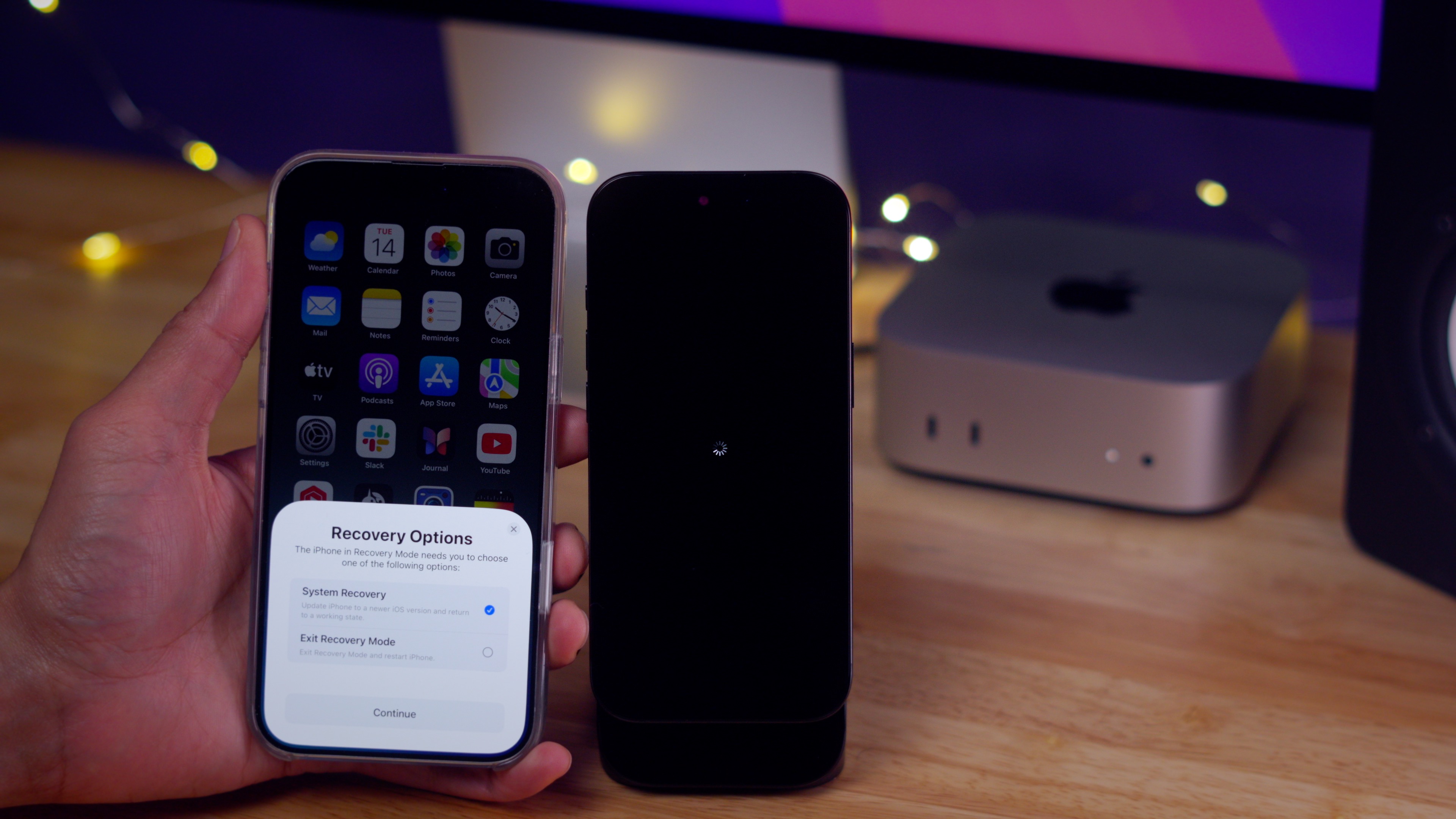
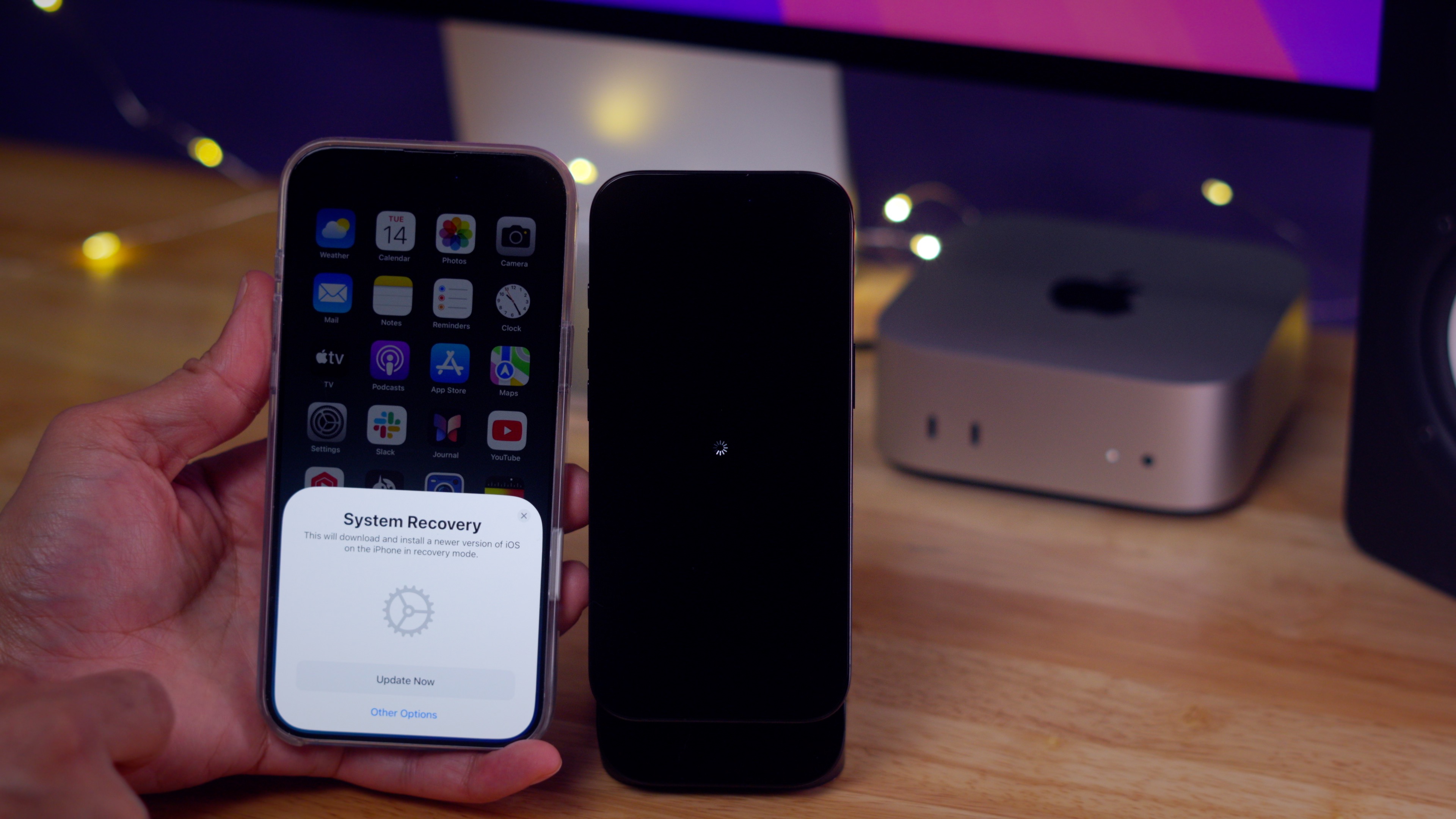
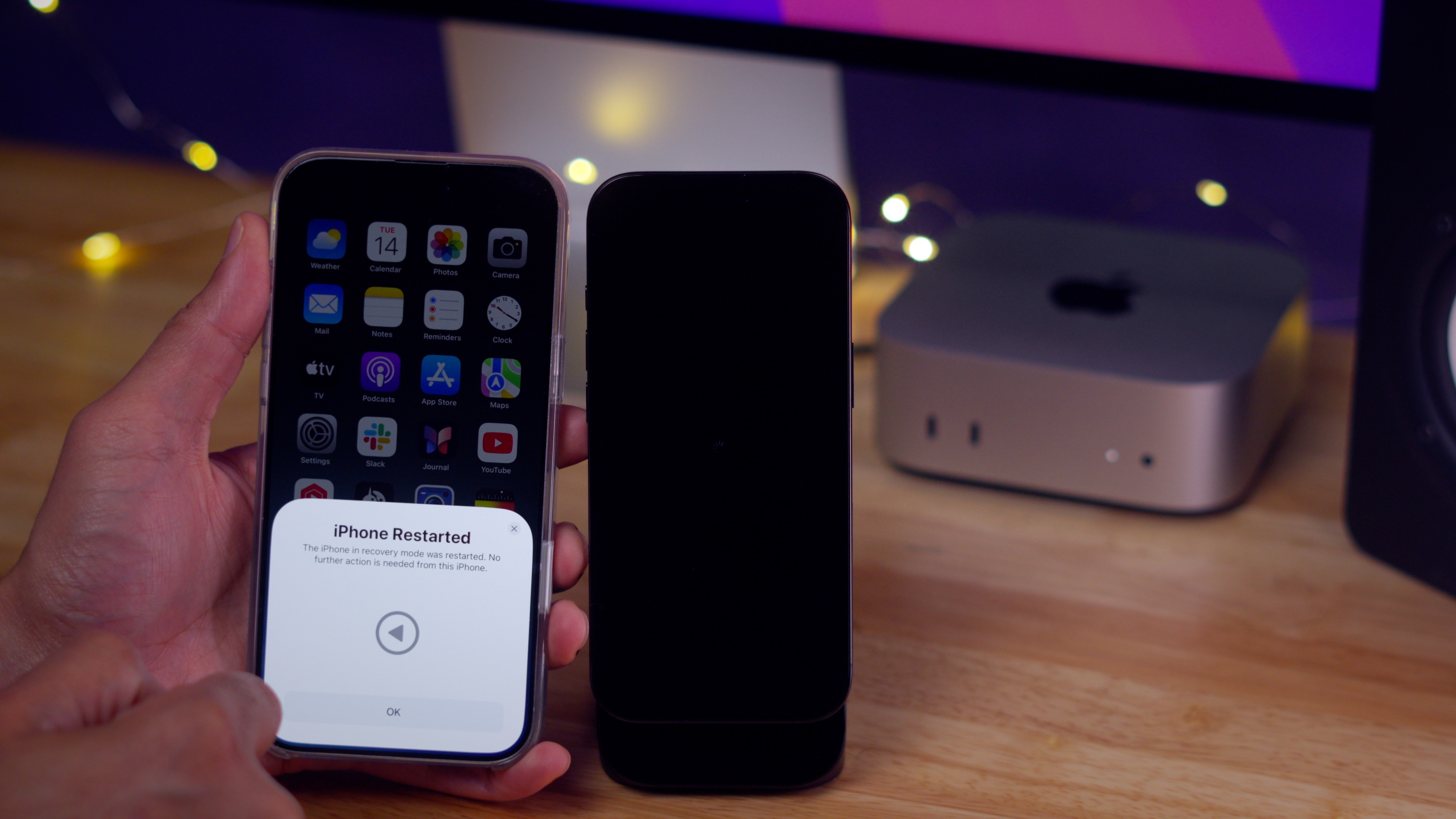
Wireless Restore – System Recovery
If the Exit Recovery option fails, you will need to perform a System Recovery using wireless restore. Follow steps 1-7 above, and then do the following:
Step 1: On the Recovery Options dialogue on the working iPhone, you will see two options: System Recovery and Exit Recovery Mode. Choose System Recovery mode and tap Continue.
Step 2: Tap Update now to download and install the latest version of iOS on the iPhone in recovery mode.
Keep the iPhone in recovery mode connected to power. You can use the working iPhone as you normally would by tapping OK, and the other iPhone will continue to restore. To view process of the restore, simply move the each device close to one another. This process will take a while since it has to prepare, download the firmware, and install the update.
How to enter DFU mode on iPhone 16
In some super-rare cases, you may need to place your iPhone 16 into Device Firmware Upgrade aka DFU mode in order to reinstall iOS by uploading firmware directly via USB. Similarly to recovery mode, you’ll need to connect your iPhone 16 to your Mac using a USB-C. If this is the first time connecting your iPhone to your Mac, you’ll need to go through the aforementioned trust process, as I explained in the recovery mode section of this tutorial above.
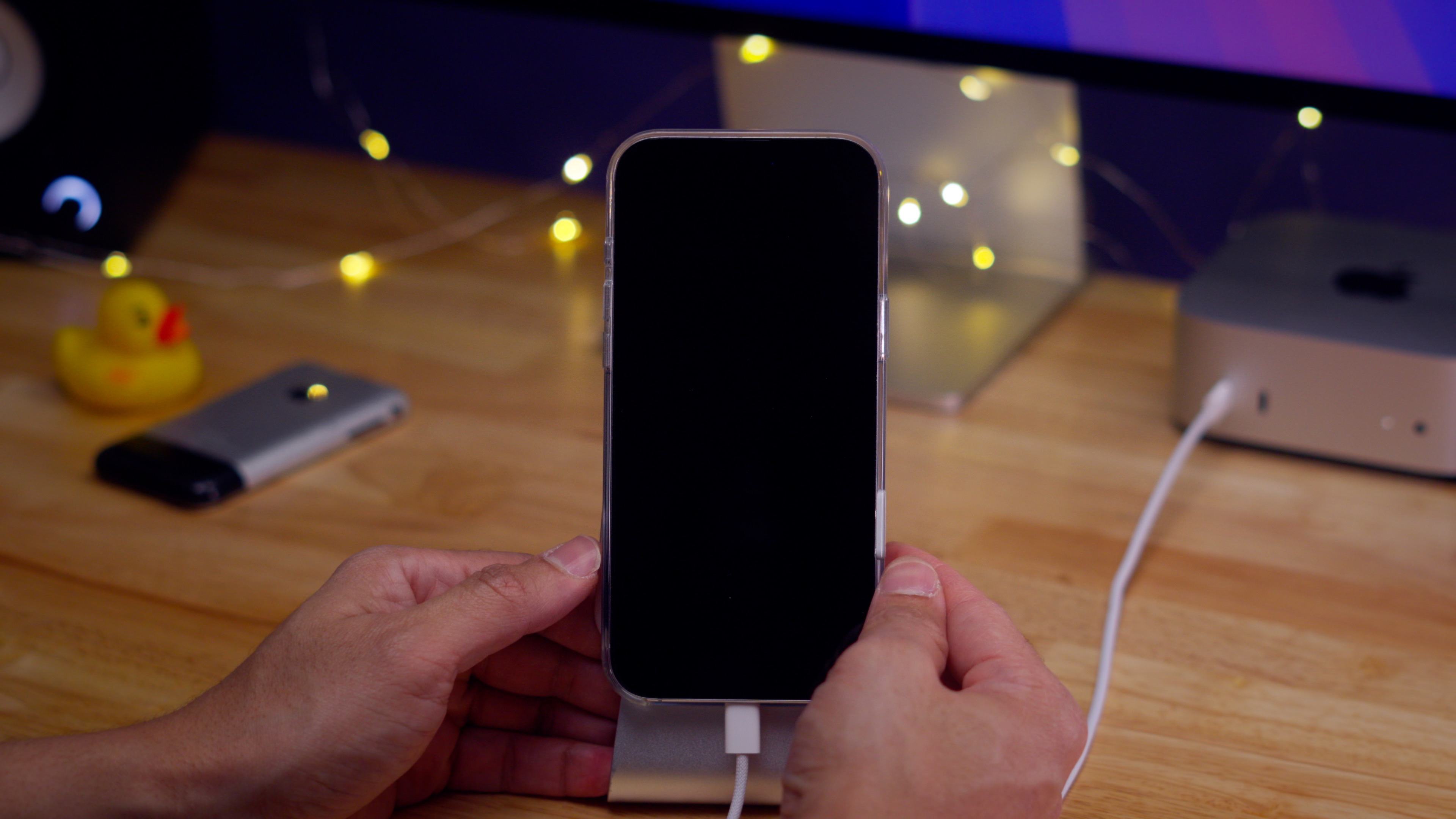
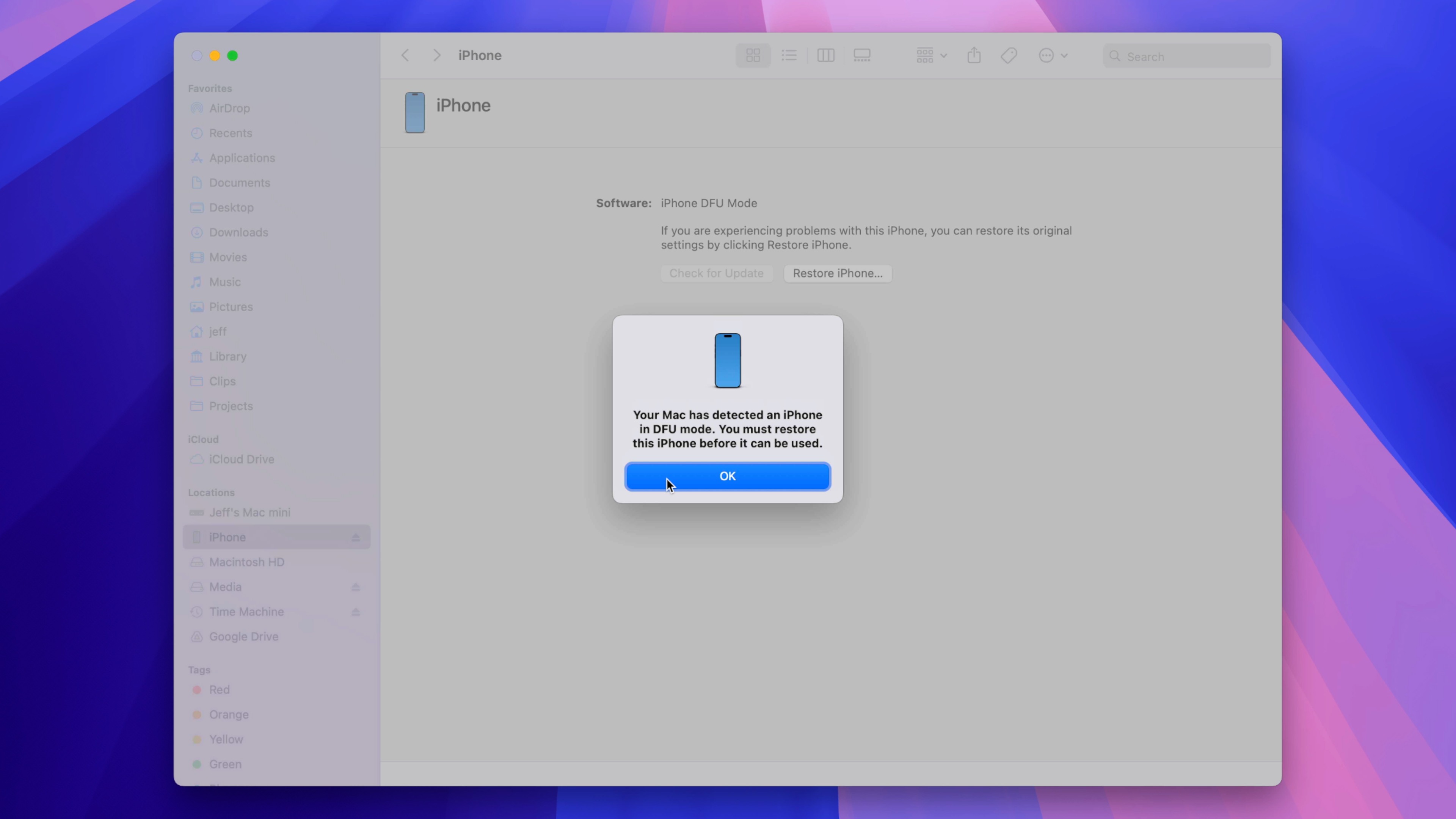
To place your iPhone 16 into DFU mode, do the following steps in quick succession:
Step 1: Quick-press the Volume up button and release.
Step 2: Quick-press the Volume down button and release.
Step 3: Long-press the Side button for 10 seconds.
Step 4: While continuing to long-press the Side button, long-press Volume down for 5 seconds.
Step 5: Release the Side button while continuing to long-press Volume down button for an additional 10 seconds.
Unlike recovery mode, you won’t see a no connect-to-computer screen displayed when entering DFU mode. After entering DFU mode, your iPhone 16’s display will remain black. Keep in mind that if the Apple logo appears during the above steps, the process was not performed correctly.
How to exit DFU mode on iPhone 16
Step 1: Quick-press the Volume up button and release.
Step 2: Quick-press the Volume down button and release.
Step 3: Long-press the Side button until the Apple logo appears. Your iPhone 16 will boot back to the Lock screen.
How to temporarily disable Face ID on iPhone 16
Long-press the Side button and either Volume button until the slide to power off slider is displayed. Face ID is now disabled. To reactivate Face ID, you’ll need to unlock your iPhone 16 with your device passcode.
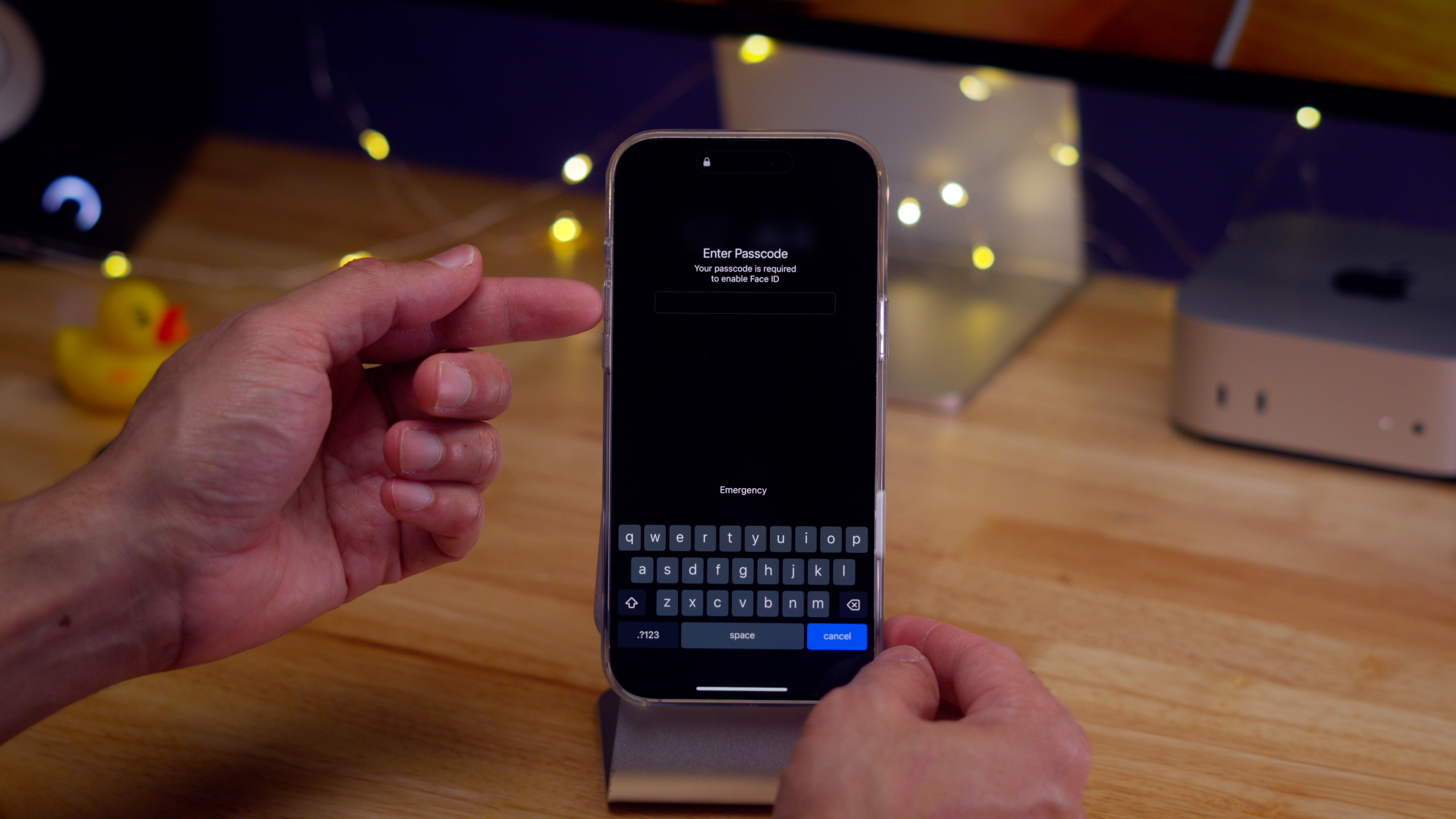
How to use Emergency SOS with iPhone 16
Warning: Triggering Emergency SOS will contact emergency authorities in your area. Please only use this feature when there is a real emergency.
There are three ways to trigger Emergency SOS on iPhone 16:
- Long-press the Side button and one of the Volume buttons simultaneously until Emergency SOS is triggered. This method allows you to enable Emergency SOS discretely without taking your iPhone 16 out of your pocket.
- Visit Settings → Emergency SOS, and enable the Call with Side Button toggle. This feature lets you trigger Emergency SOS by quick-pressing the Side button 5 times in a row. Again, this can be done discretely without removing your iPhone 16 from your pocket.
- Long-press the Side button on your iPhone 16 along with one of the Volume buttons simultaneously until the slide to power off slider is displayed. Use the Emergency SOS slider to activate Emergency SOS.
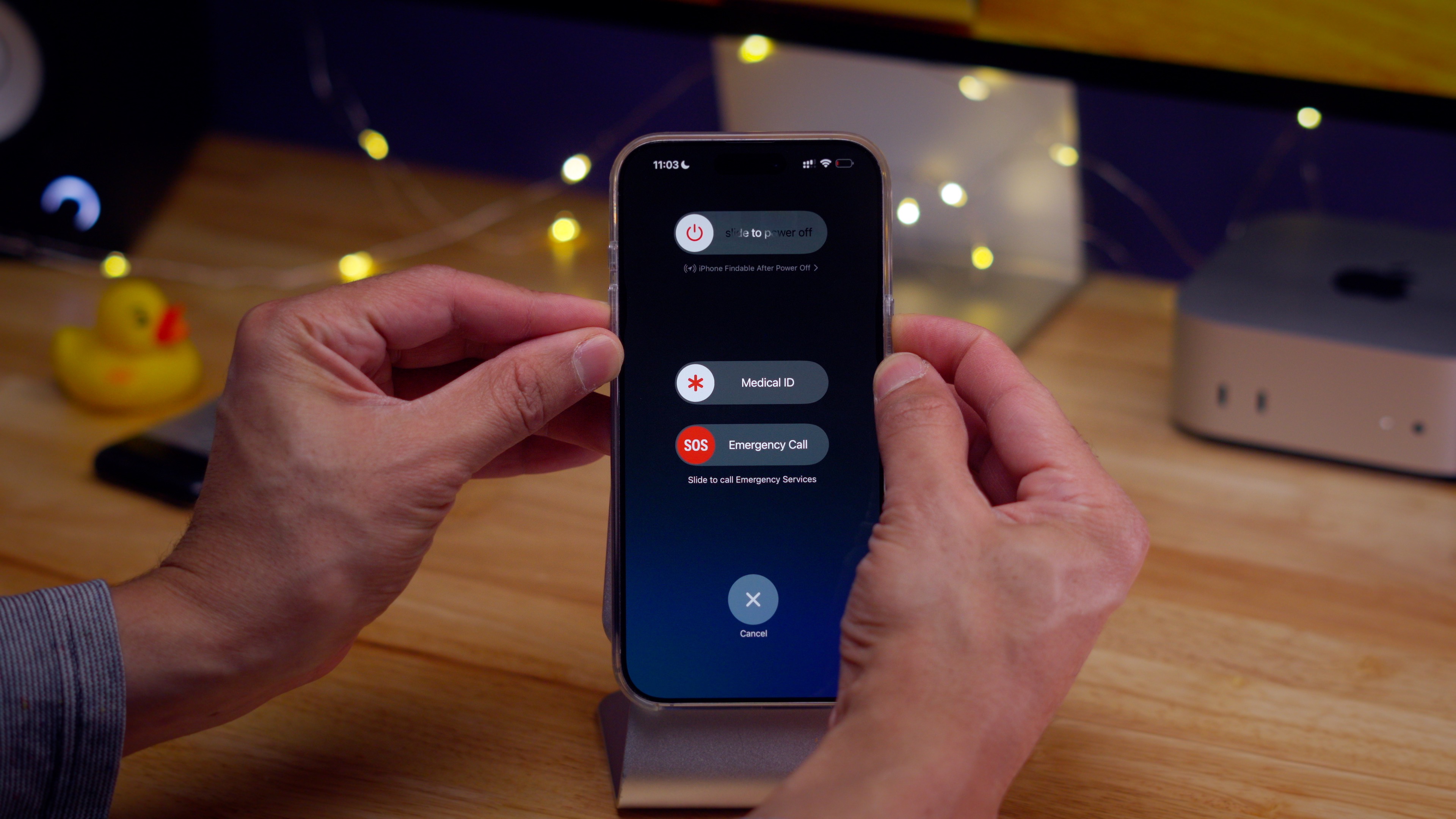
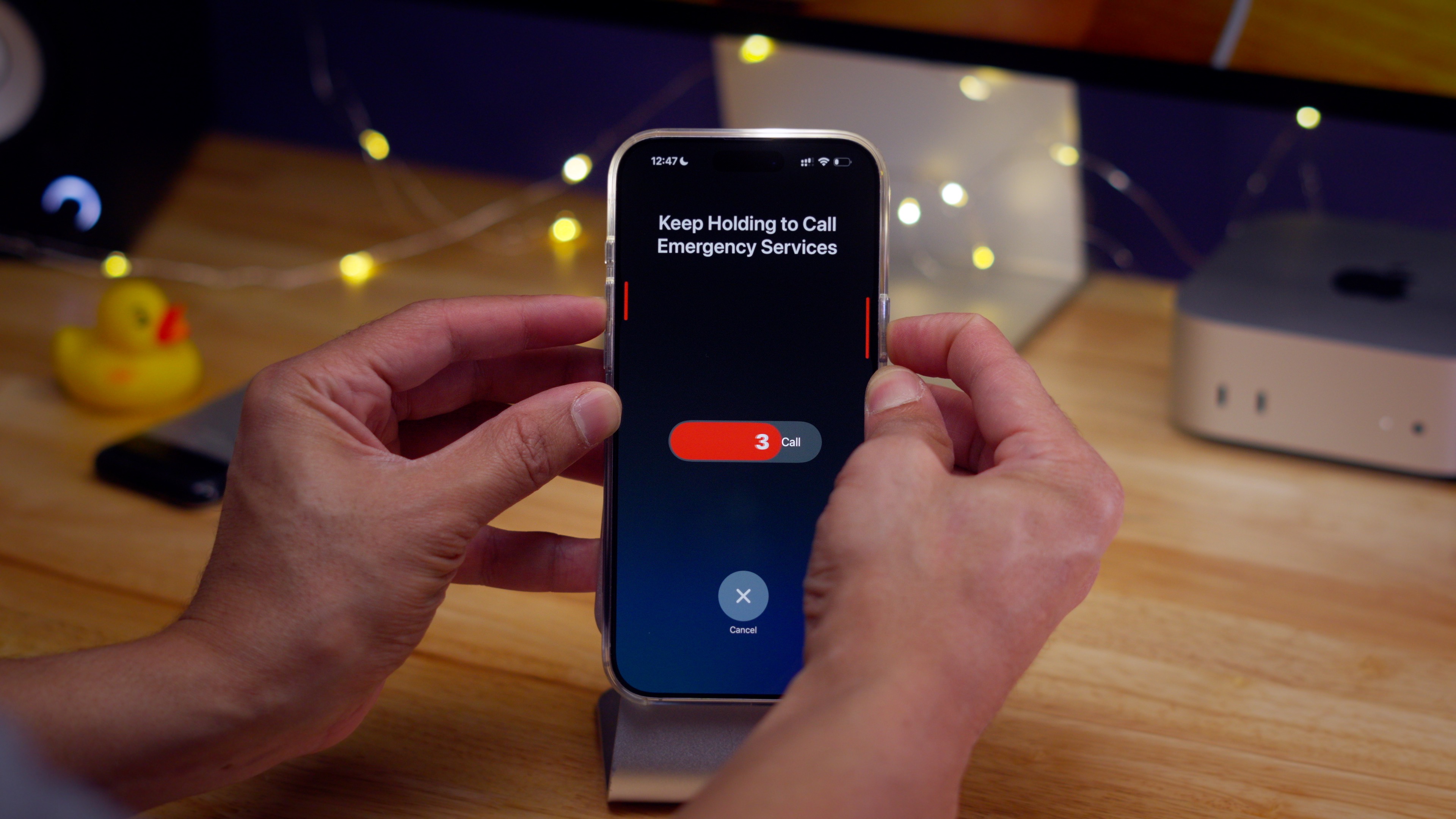
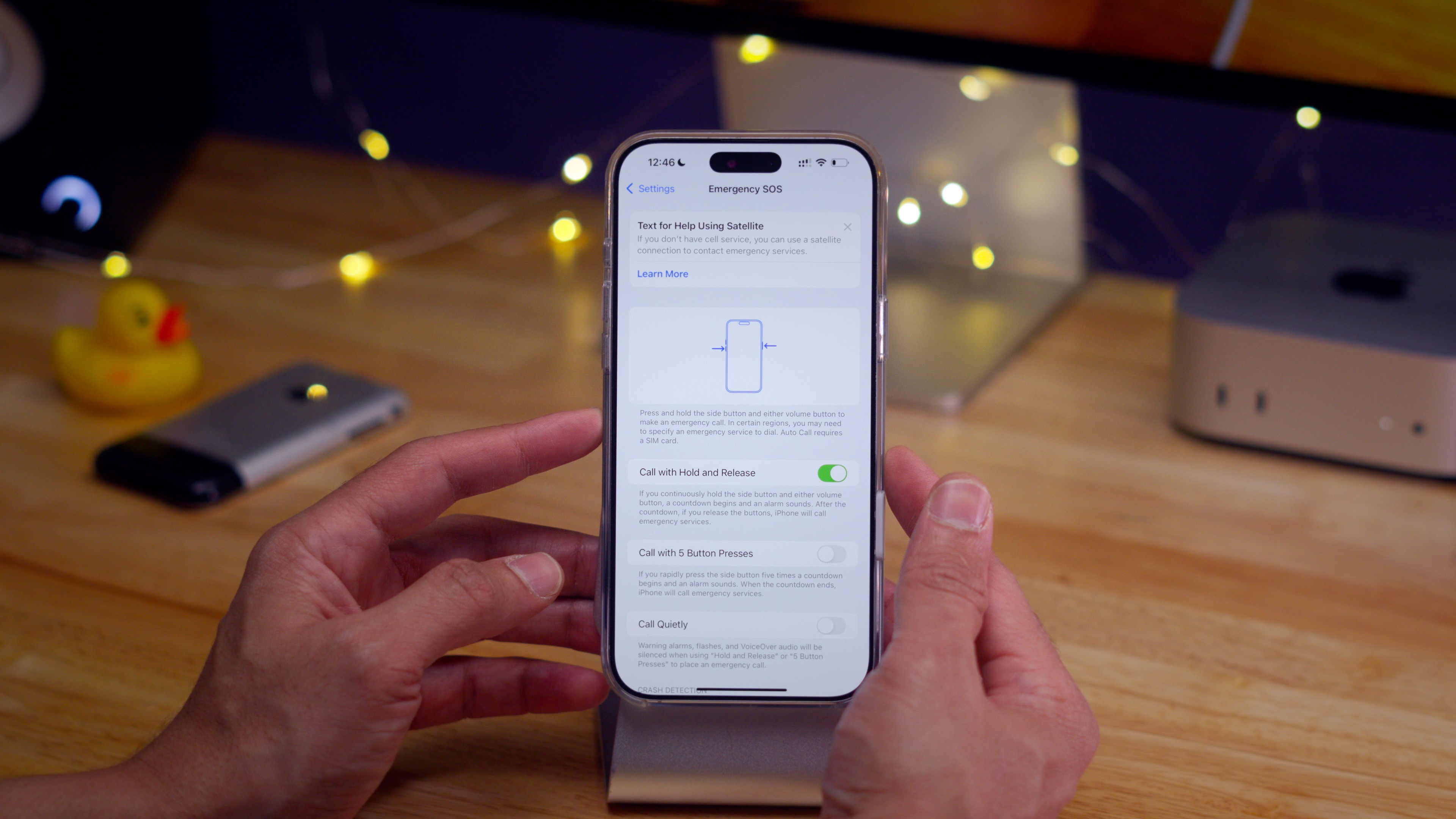
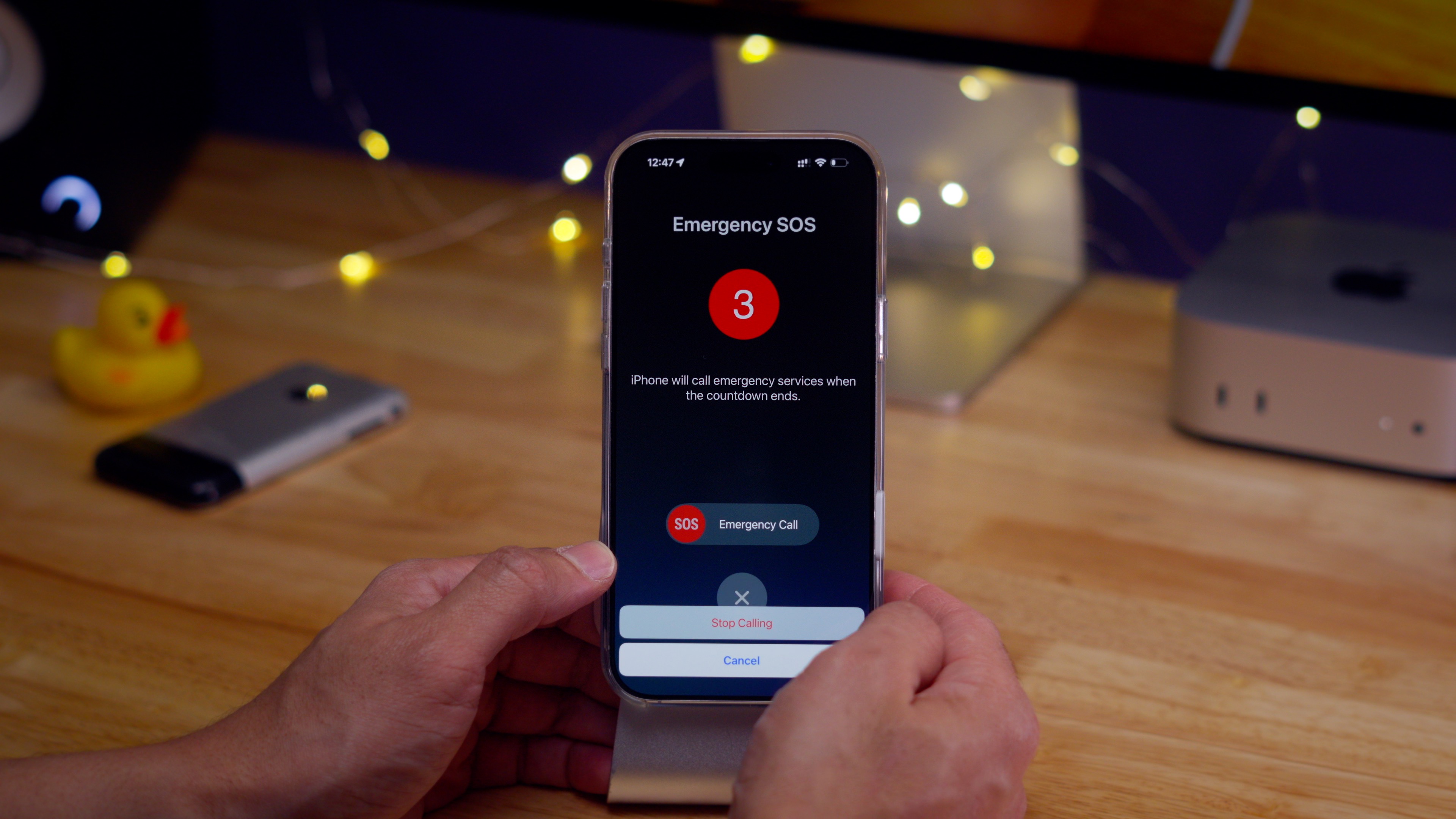
For an even more discrete option, there is also a Call Quietly option in Settings → Emergency SOS. Enabling this feature will silence Emergency SOS warning alarms, flashes, and Voice Over audio for a more discrete trigger option.
Also related to Emergency SOS is the Crash Detection toggle in Settings → Emergency SOS. This option will cause your iPhone 16 to automatically call emergency services if it detects that you’ve been in a car crash.
How to disable Find My when powering down iPhone 16
iOS 18 includes a feature that lets your iPhone 16 continue to be tracked via the Find My network, even when powered down. To use this feature, you’ll need to have your iPhone 16 logged in to the Find My network, and have location services enabled.
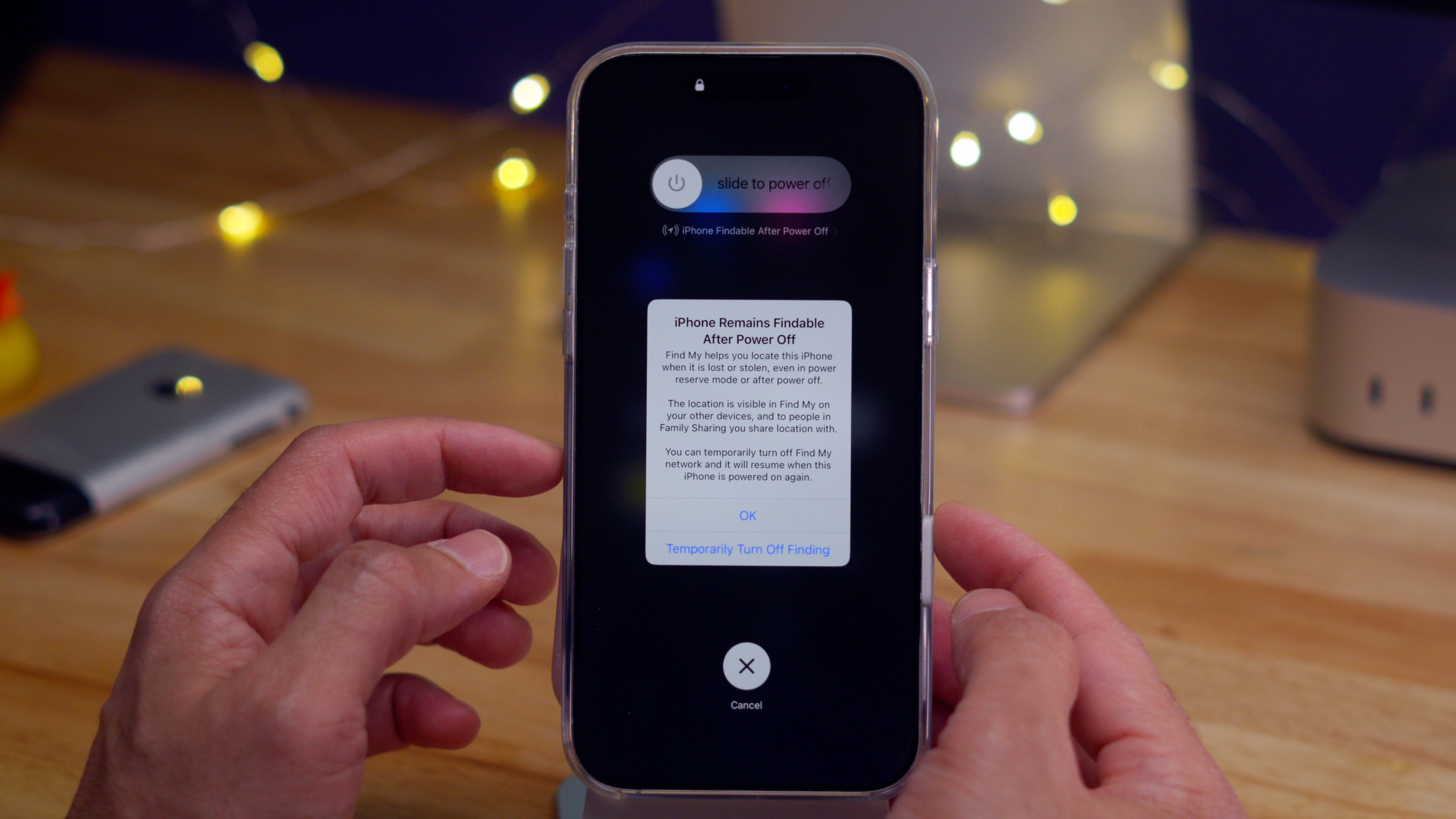
How to tell the time when your iPhone 16 battery is dead
New for iOS 18 is a feature that lets you tell the current time, even when your iPhone 16 is dead. To do so, simply press the Side button once, and you should see the time listed in the upper right-hand corner of its display.
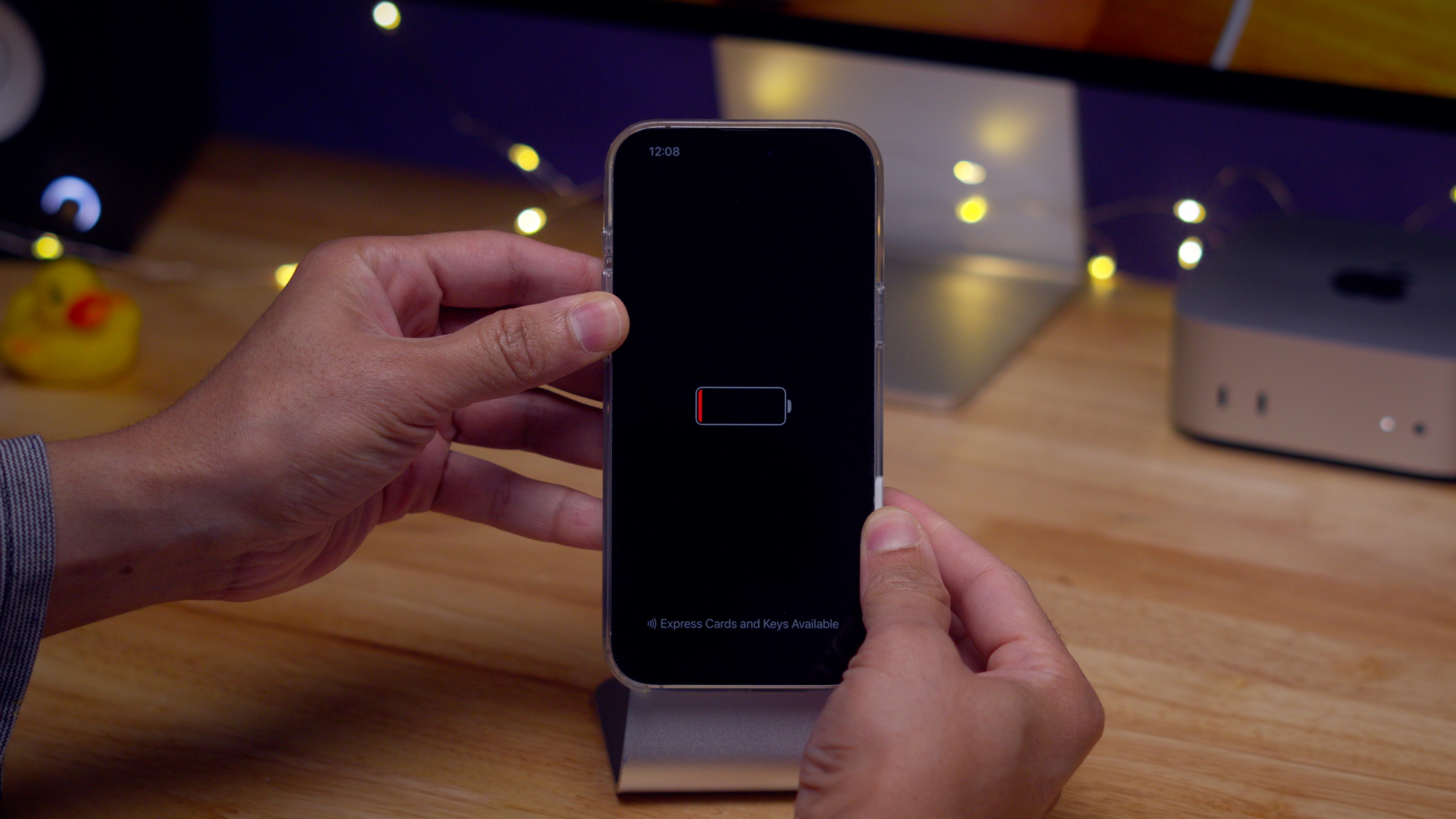
How to use Home Key when your iPhone 16 battery is dead
If you have an Apple Home Key-compatible smart lock installed, like the Aqara U100 (review), Schlage Encode Plus (review), or Level Lock+ (review), then you’ll be happy to know that you can also unlock your door with your iPhone 16 even when the phone is dead and out of battery. First, make sure that Express Mode is enabled for your Lock, under the Home Key settings in the Wallet app. When you press the Side button on your dead iPhone 16, you should see a message at the bottom of the display that says Express Cards and Keys Available.
To unlock, simply hold your iPhone next to your Home Key lock, and the door should unlock, although there will be nothing displayed on your iPhone’s display, and no chimes will sound, since the battery is dead.
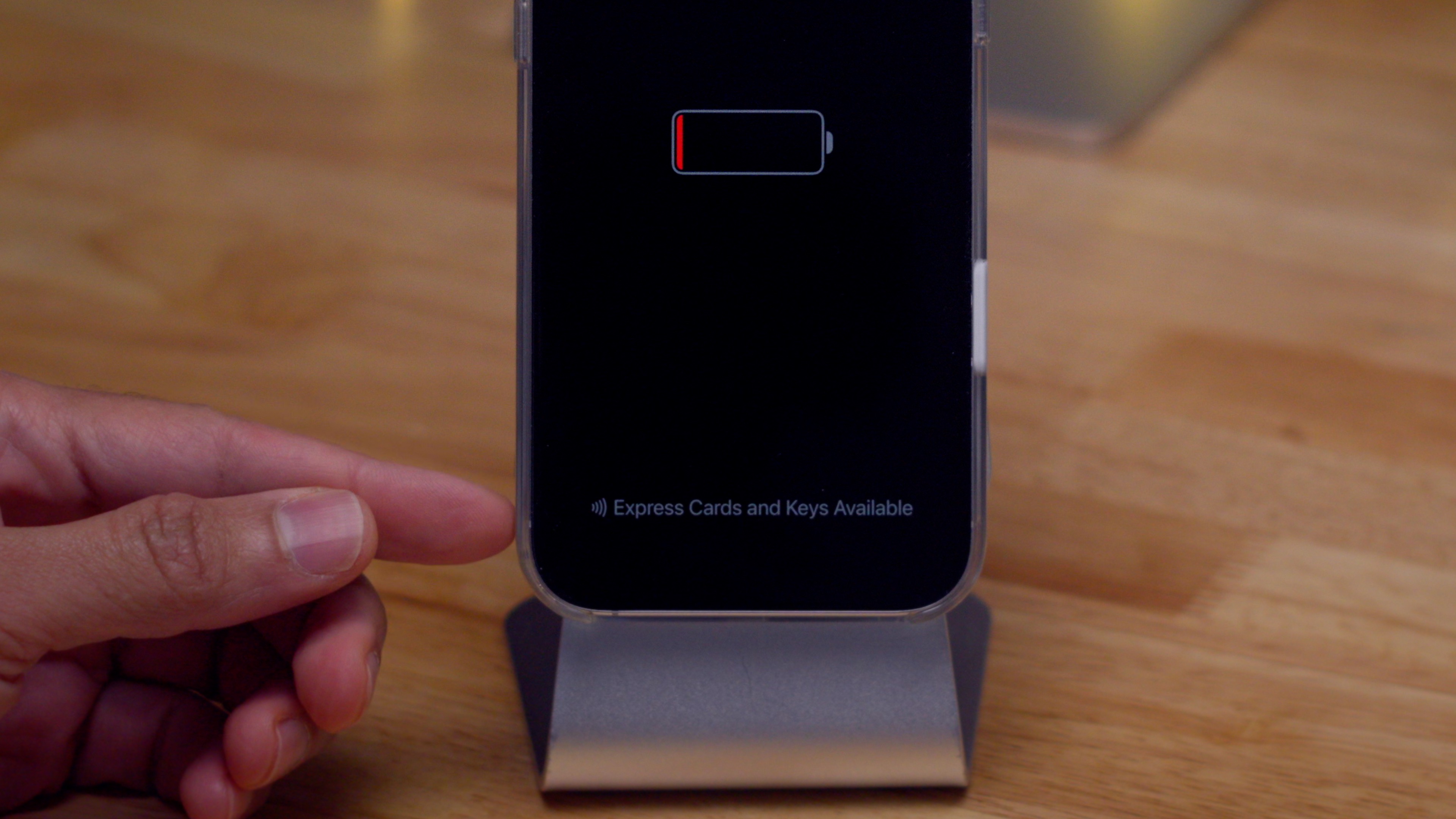
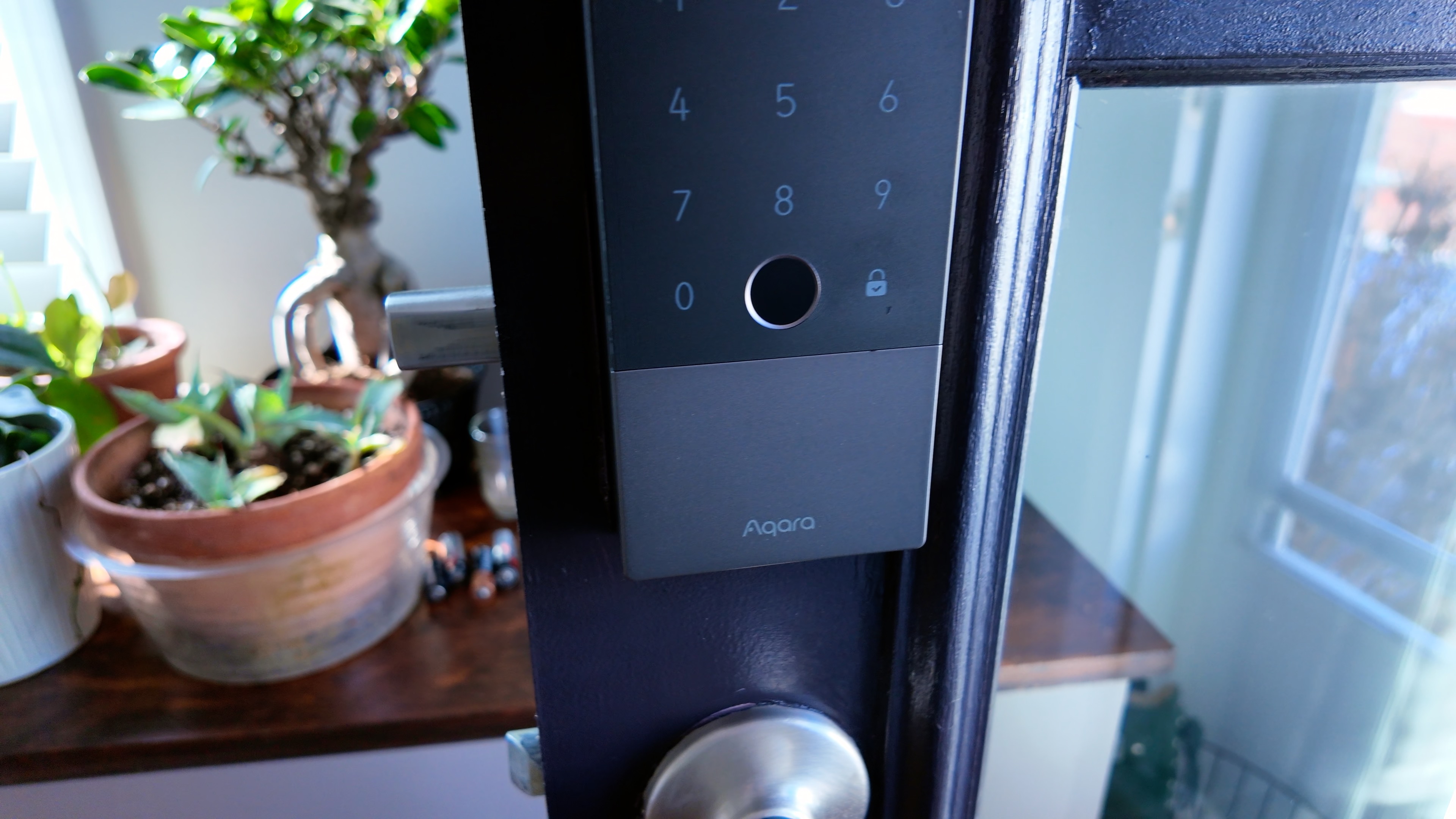
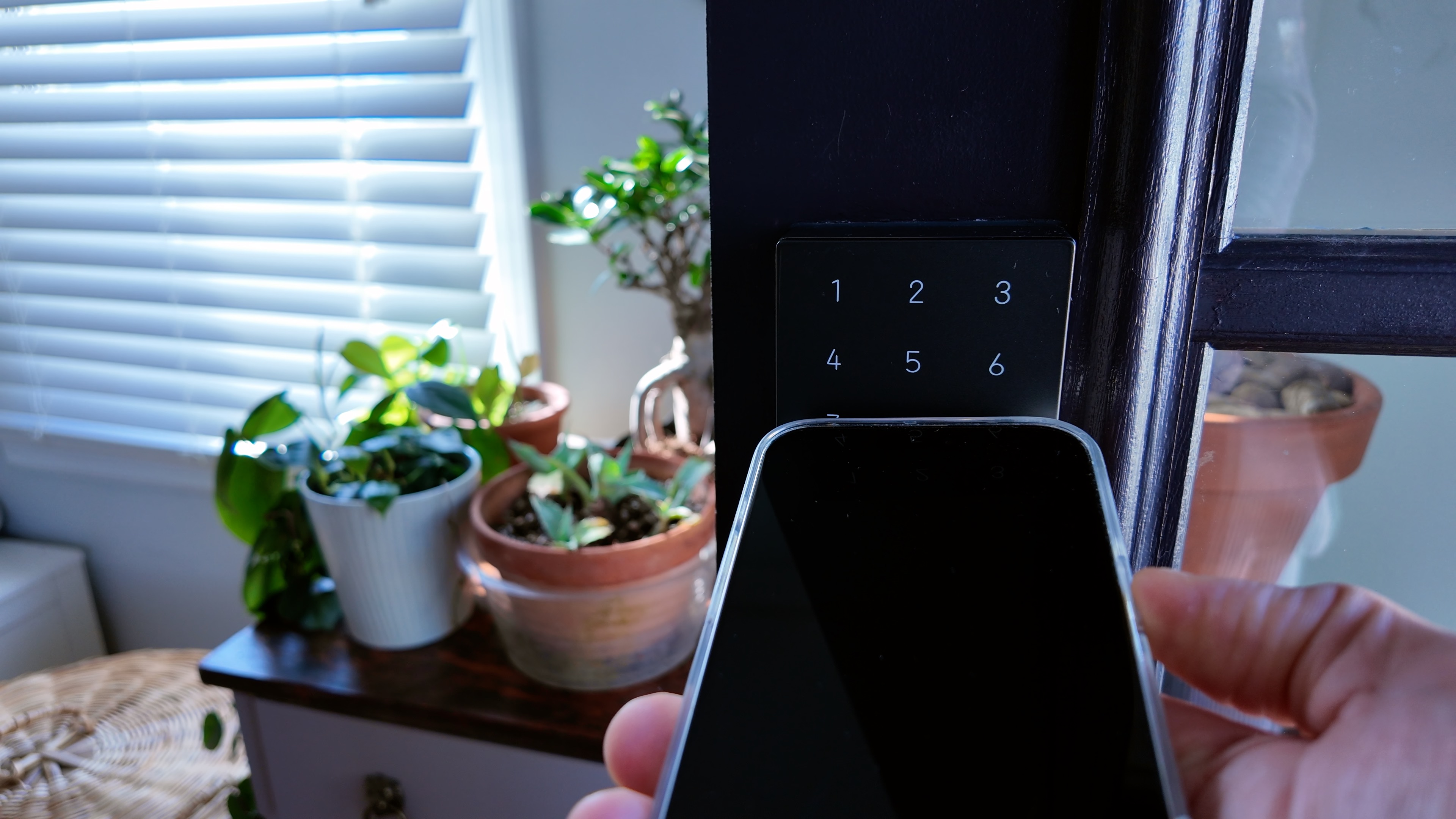
9to5Mac’s Take
It’s not often that you’ll need to use recovery mode, and even less likely that DFU mode access will come into play play. But these are handy tips that every iOS user should know. Especially handy is the ability to force restart an iPhone 16 that’s acting weird, even casual iPhone 16 users should be well aware of this feature, and some of the other utility features within iOS 18 like wireless restore. What are your thoughts? Sound off down below in the comments!
FTC: We use income earning auto affiliate links. More.




